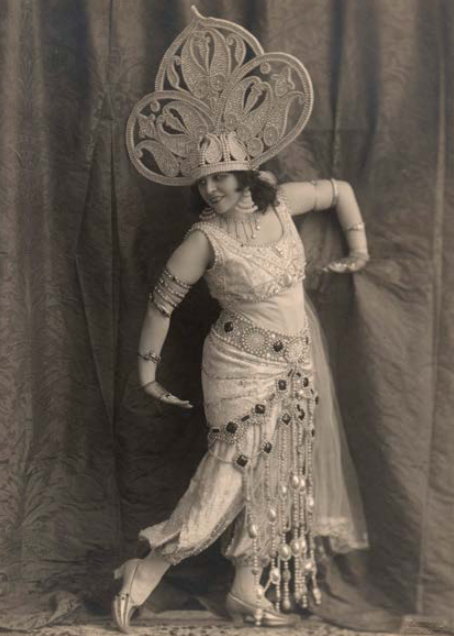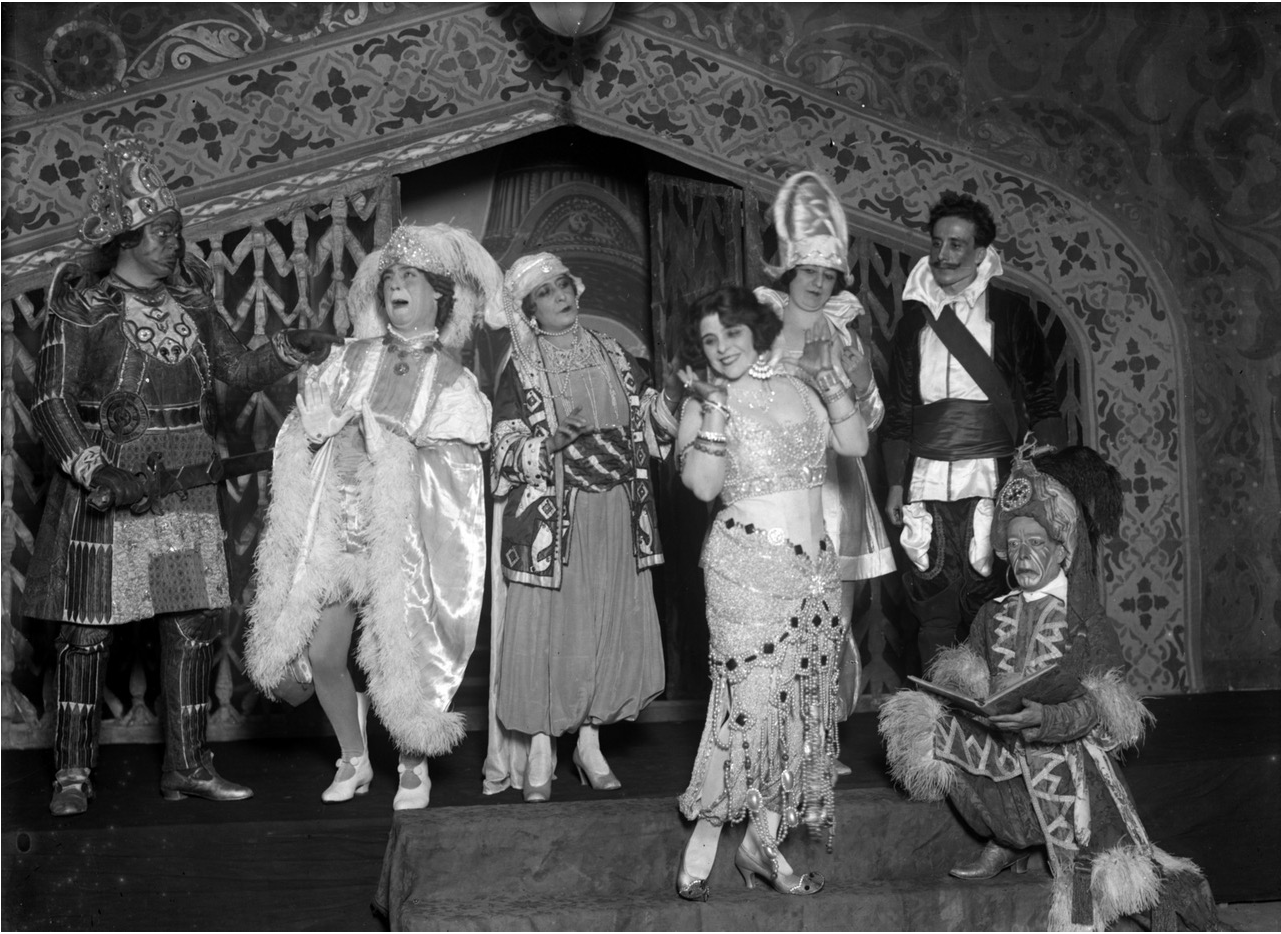Ignacio Jassa Haro
Operetta Research Center
14 April, 2021
At a time when the Covid-19 situation generates distress in our daily lives, Madrid’s Teatro de la Zarzuela presents a staging that aspires to be an injection of optimism, both for the Madrilenians who can come to the Calle Jovellanos, but also for online audiences in every corner of the planet. On 14 April a new production of the gender-bending zarzuela Benamor premieres: a spectacular, funny and transgressive 1923 title with music by Pablo Luna. (You can download a PDF of the program on the theater’s website, it contains a full English language plot outline.)

The official poster image and cover of the program book for “Benamor,” Madrid 2021. (Photo: Teatro de la Zarzuela)
The Madrid theatre has decided to rescue a title that was forgotten – unfairly – for decades, possibly due to a double obstacle: its costly to stage and has a somewhat “delicate” plot.
The setting is 16th century Persia. Which made the original staging at the same theatre a milestone in the history of Spanish costume and set design, thanks to designer Josep Castells. And of course there’s a total lack of so called “political correctness” in this libretto that tells the story of the self-discovery of two siblings, Sultan Darius and Princess Benamor. They are both raised in the opposite gender to the one they were born into. After discovering that their felt gender does not match their biological gender, three acts of amusing adventures unfold, allowing the spectator to put themselves in the shoes of two trans people and to witness their non-normative sexual orientations. Even though, in the end ( it could not be otherwise in 1923), they are lead “back” to being cis-gendered and heteronormative.
The plot is surprisingly similar to that of L’Île de Tulipatan (1868), whose English adaptation changes the original location from a fantasy island to – Persia! (Read more about it here.) Although Jacques Offenbach’s one-act opéra bouffe had two Spanish versions (1869 and 1875) it seems unlikely that its impact reached Benamor‘s authors. In reality, Antonio Paso Cano and Ricardo González del Toro wrote the work as a vehicle for Esperanza Iris, a great Mexican diva who commissioned it for production during her second European tour. The authors took the play Kismet (1911) as their aesthetic reference point, also its two great musical derivations of 1916: Chu Chin Chow (with music by Frederic Norton) and El asombro de Damasco (with score by Pablo Luna himself).

The diva Esperanza Iris in “Benamor” in Mexico, 1923. (Photo: Archivo Esperanza Iris, Instituto Nacional de Bellas Artes y Literatura. Centro Nacional de Investigación, Documentación e Información Teatral Rodolfo Usigli, México)
To add to the transnational influences, Luna brought the latter piece to the UK under the title The First Kiss (1923-1924). As Andrew Lamb and Christopher Webber have pointed out, the notable differences in book and music from the original makes The First Kiss a new work; some of the newly added musical material was reused in Benamor after it didn’t make the hoped for leap to the West End after an initial British tour (the leap will come, but not until 1924).

Sheet music cover for Pablo Luna’s “The First Kiss,” London 1924. (Photo: Christopher Webber Personal Collection)
Pablo Luna was a man of the theatre with a vast catalogue of works, many of them very successful, in which he displays a powerful musical personality while reflecting the impact of the popular musical and operatic theatre of his time. He adapted numerous operettas, from Die Dollarprinzessin to Ball im Savoy, but also Paganini, Szibill and Im weißen Rössl.
Benamor‘s two best-known moments, captured on record in 1923, were curiously written for their premiere on the English stage, although they ended up making the show set in Persia famous: the Spanish song “País de sol” (immortalised by numerous baritones such as Marcos Redondo).
And then there’s also the dazzling “Danza del fuego.”
But the richness and variety of the score show us a true musical dramatist, Pablo Luna, who sets the “trans drama” of the two siblings to music (with developed trios, duets or concertantes) and at the same time enlivens the otherwise “frivolous” evening (with a long succession of light numbers that in many cases draw on rhythms from the other side of the Atlantic).
The rediscovery of this show, with which Esperanza Iris gave the definitive backing to a solid international career on the Spanish-speaking stages around the world, has been made possible thanks to the existence of Pablo Luna’s personal collection, which is kept in the Documentation and Archive Centre of the General Society of Authors and Publishers (SGAE), in Madrid. Thanks to the original orchestral materials and the typewritten dratfs of the libretto, this musicological centre has been able to produce a modern edition of Pablo Luna’s legendary work. In addition, it has been possible to recover a key number that had been discarded: a trio from the first act of enormous dramaturgical importance and charged with homoeroticism.

The composer Pablo Luna in Madrid, 1920. (Photo: Centro de Documentación y Archivo de la Sociedad General de Autores y Editores, SGAE, Madrid)
For its part, the Teatro de la Zarzuela has provided the means to make this rescue enterprise a memorable occasion: from the set designs by Daniel Bianco (the theatre’s renowned director) and the costumes by Gabriela Salaverri, who has opted for a classically orientalist aesthetic, to a double cast of veteran artists captained and directed by the singer and showman Enrique Viana, who has also signed the dramaturgical adaptation.

Esperanza Iris performing “Belamor” in Mexico. (Photo: National Archive of Mexico)
With this production, the theatre further investigates Pablo Luna oeuvre with oriental settings, after El asombro de Damasco and El niño judío (1918). Moreover, the work arrives less than a month after the revival of Las Calatravas (1941) in a concert version. It’s a touching posthumous title from Pablo Luna’s catalogue, written in the midst of the Spanish Civil War.
Almost a hundred years after Benamor‘s music was first heard in different ways in England, Cuba and Mexico, we can again dream of a new transnational journey this title might make today. The powerful queer story and the delightful score could stir interest with audiences elswhere, from the USA to Germany and Austria.
To production will be streamd on 22 April at 8 pm, Central European time.
You can watch Ignacio Jassa Haro discuss Benamor in a video presentation (in Spanish) below:

I’ve been enjoying Benamor, but would like to know details of the plot. Neither of the links in the article to a full plot description are working (or at least not on my computer.)
Dear Gavid, you can download a PDF of the program here:
http://teatrodelazarzuela.mcu.es/es/temporada/lirica-2020-2021/download/496_c346904767d3e5cc4e5d68269cfab990
My best wishes!